Analyzing the Effects of Excessive Online Time on Young People's Lives
VerifiedAdded on 2022/11/14
|6
|1512
|150
Essay
AI Summary
This essay explores the detrimental effects of excessive online time on young people, highlighting issues such as increased depression rates, decreased face-to-face communication, and the rising concerns of cyberbullying and sleep loss. It analyzes how dependence on online media and social media platforms alters communication patterns, leading to less personal interactions and a reliance on instant gratification. The essay also discusses the overlap between online and offline lives, emphasizing the concerns parents have regarding their children's online activities and their impact on social interactions. Ultimately, the analysis concludes that excessive internet use contributes to various problems affecting the well-being and social development of young individuals.
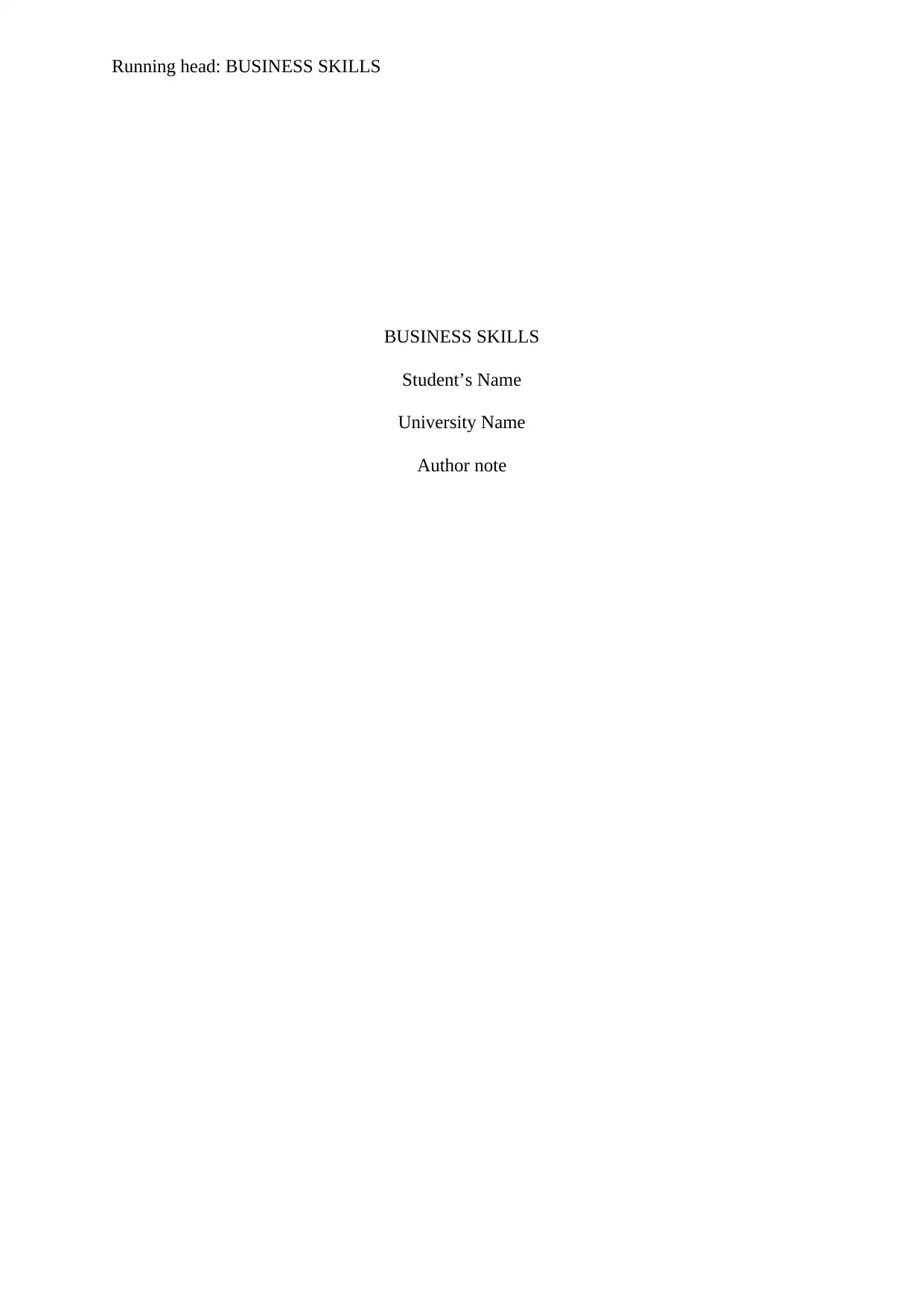
Running head: BUSINESS SKILLS
BUSINESS SKILLS
Student’s Name
University Name
Author note
BUSINESS SKILLS
Student’s Name
University Name
Author note
Paraphrase This Document
Need a fresh take? Get an instant paraphrase of this document with our AI Paraphraser
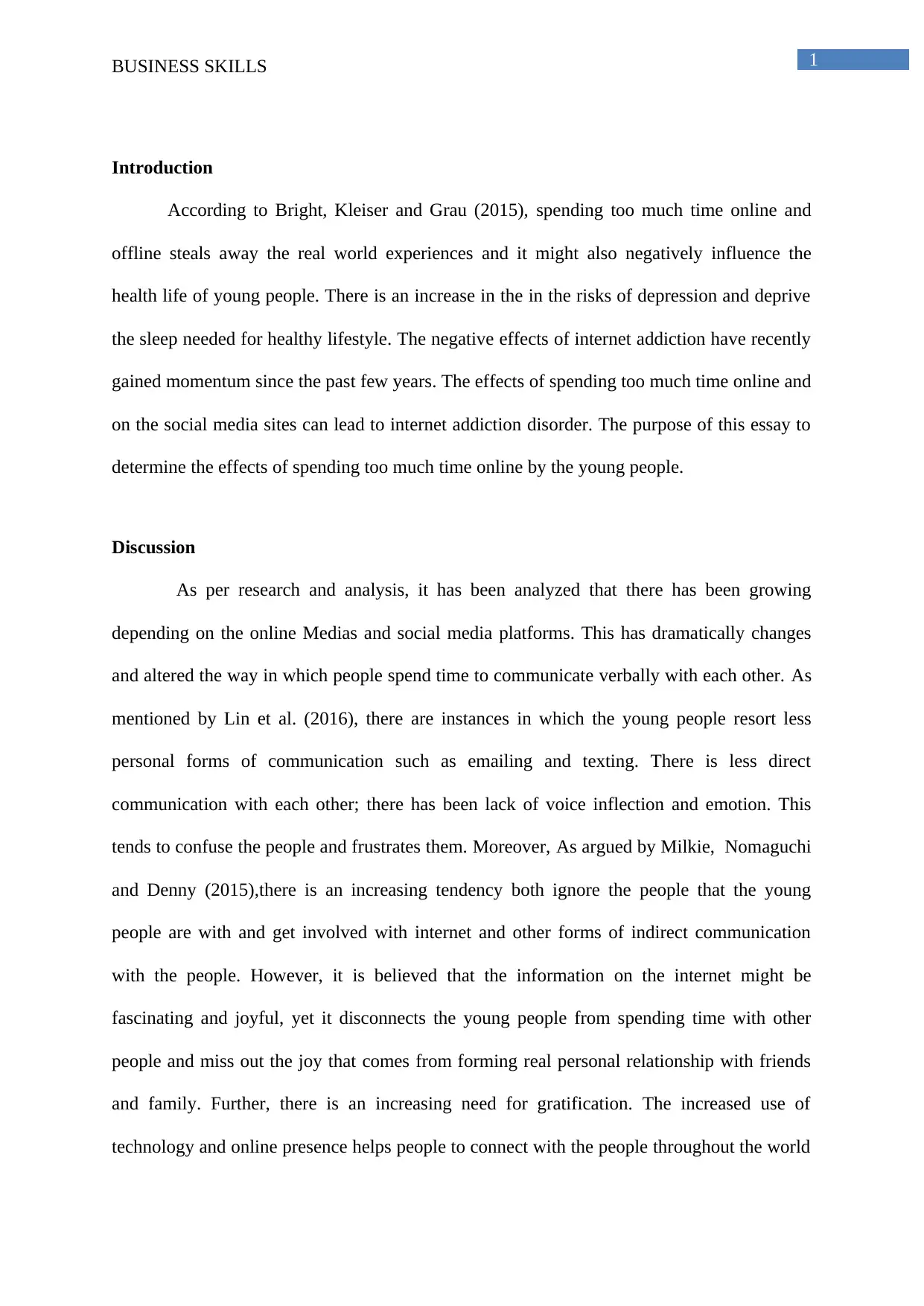
1BUSINESS SKILLS
Introduction
According to Bright, Kleiser and Grau (2015), spending too much time online and
offline steals away the real world experiences and it might also negatively influence the
health life of young people. There is an increase in the in the risks of depression and deprive
the sleep needed for healthy lifestyle. The negative effects of internet addiction have recently
gained momentum since the past few years. The effects of spending too much time online and
on the social media sites can lead to internet addiction disorder. The purpose of this essay to
determine the effects of spending too much time online by the young people.
Discussion
As per research and analysis, it has been analyzed that there has been growing
depending on the online Medias and social media platforms. This has dramatically changes
and altered the way in which people spend time to communicate verbally with each other. As
mentioned by Lin et al. (2016), there are instances in which the young people resort less
personal forms of communication such as emailing and texting. There is less direct
communication with each other; there has been lack of voice inflection and emotion. This
tends to confuse the people and frustrates them. Moreover, As argued by Milkie, Nomaguchi
and Denny (2015),there is an increasing tendency both ignore the people that the young
people are with and get involved with internet and other forms of indirect communication
with the people. However, it is believed that the information on the internet might be
fascinating and joyful, yet it disconnects the young people from spending time with other
people and miss out the joy that comes from forming real personal relationship with friends
and family. Further, there is an increasing need for gratification. The increased use of
technology and online presence helps people to connect with the people throughout the world
Introduction
According to Bright, Kleiser and Grau (2015), spending too much time online and
offline steals away the real world experiences and it might also negatively influence the
health life of young people. There is an increase in the in the risks of depression and deprive
the sleep needed for healthy lifestyle. The negative effects of internet addiction have recently
gained momentum since the past few years. The effects of spending too much time online and
on the social media sites can lead to internet addiction disorder. The purpose of this essay to
determine the effects of spending too much time online by the young people.
Discussion
As per research and analysis, it has been analyzed that there has been growing
depending on the online Medias and social media platforms. This has dramatically changes
and altered the way in which people spend time to communicate verbally with each other. As
mentioned by Lin et al. (2016), there are instances in which the young people resort less
personal forms of communication such as emailing and texting. There is less direct
communication with each other; there has been lack of voice inflection and emotion. This
tends to confuse the people and frustrates them. Moreover, As argued by Milkie, Nomaguchi
and Denny (2015),there is an increasing tendency both ignore the people that the young
people are with and get involved with internet and other forms of indirect communication
with the people. However, it is believed that the information on the internet might be
fascinating and joyful, yet it disconnects the young people from spending time with other
people and miss out the joy that comes from forming real personal relationship with friends
and family. Further, there is an increasing need for gratification. The increased use of
technology and online presence helps people to connect with the people throughout the world
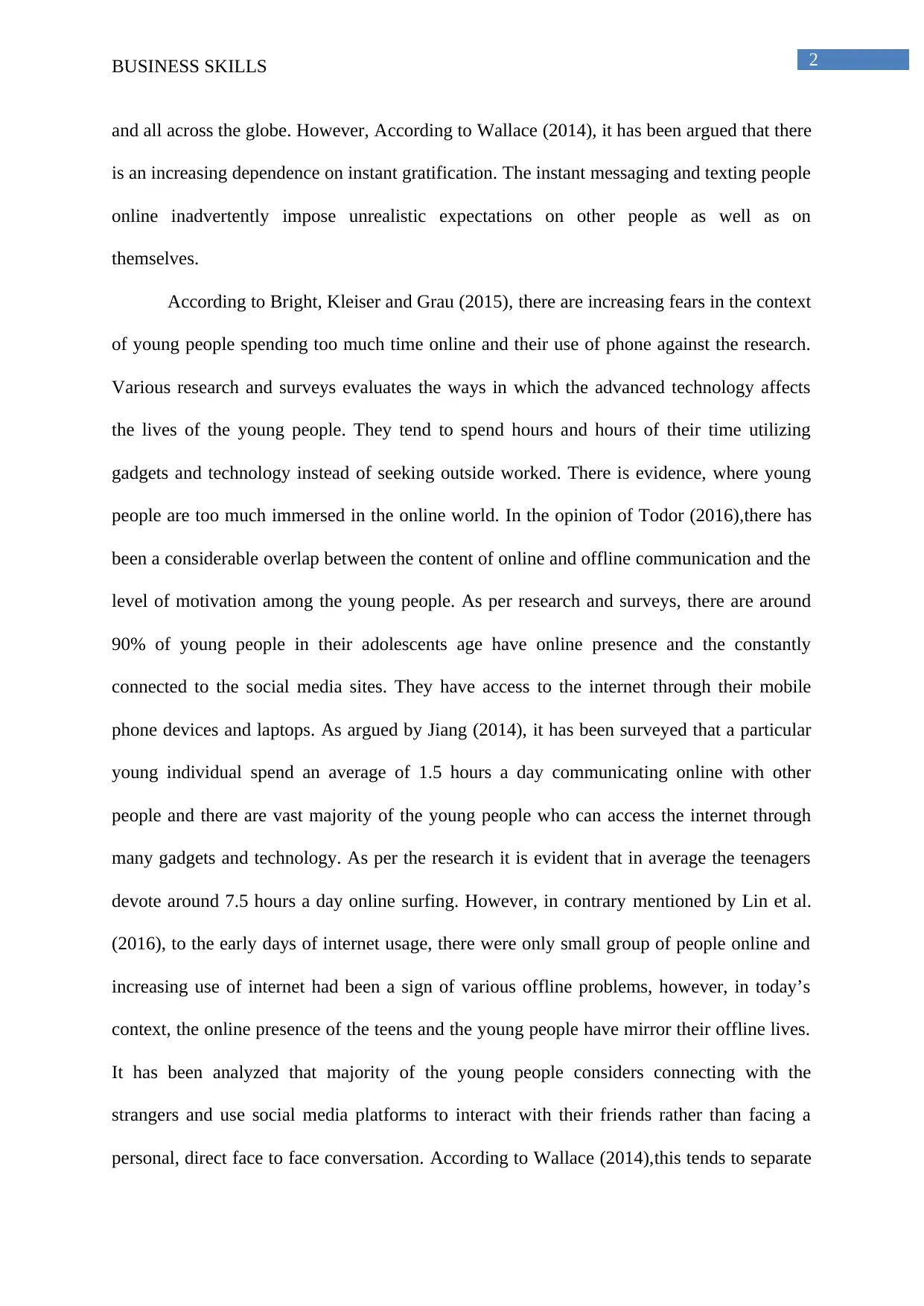
2BUSINESS SKILLS
and all across the globe. However, According to Wallace (2014), it has been argued that there
is an increasing dependence on instant gratification. The instant messaging and texting people
online inadvertently impose unrealistic expectations on other people as well as on
themselves.
According to Bright, Kleiser and Grau (2015), there are increasing fears in the context
of young people spending too much time online and their use of phone against the research.
Various research and surveys evaluates the ways in which the advanced technology affects
the lives of the young people. They tend to spend hours and hours of their time utilizing
gadgets and technology instead of seeking outside worked. There is evidence, where young
people are too much immersed in the online world. In the opinion of Todor (2016),there has
been a considerable overlap between the content of online and offline communication and the
level of motivation among the young people. As per research and surveys, there are around
90% of young people in their adolescents age have online presence and the constantly
connected to the social media sites. They have access to the internet through their mobile
phone devices and laptops. As argued by Jiang (2014), it has been surveyed that a particular
young individual spend an average of 1.5 hours a day communicating online with other
people and there are vast majority of the young people who can access the internet through
many gadgets and technology. As per the research it is evident that in average the teenagers
devote around 7.5 hours a day online surfing. However, in contrary mentioned by Lin et al.
(2016), to the early days of internet usage, there were only small group of people online and
increasing use of internet had been a sign of various offline problems, however, in today’s
context, the online presence of the teens and the young people have mirror their offline lives.
It has been analyzed that majority of the young people considers connecting with the
strangers and use social media platforms to interact with their friends rather than facing a
personal, direct face to face conversation. According to Wallace (2014),this tends to separate
and all across the globe. However, According to Wallace (2014), it has been argued that there
is an increasing dependence on instant gratification. The instant messaging and texting people
online inadvertently impose unrealistic expectations on other people as well as on
themselves.
According to Bright, Kleiser and Grau (2015), there are increasing fears in the context
of young people spending too much time online and their use of phone against the research.
Various research and surveys evaluates the ways in which the advanced technology affects
the lives of the young people. They tend to spend hours and hours of their time utilizing
gadgets and technology instead of seeking outside worked. There is evidence, where young
people are too much immersed in the online world. In the opinion of Todor (2016),there has
been a considerable overlap between the content of online and offline communication and the
level of motivation among the young people. As per research and surveys, there are around
90% of young people in their adolescents age have online presence and the constantly
connected to the social media sites. They have access to the internet through their mobile
phone devices and laptops. As argued by Jiang (2014), it has been surveyed that a particular
young individual spend an average of 1.5 hours a day communicating online with other
people and there are vast majority of the young people who can access the internet through
many gadgets and technology. As per the research it is evident that in average the teenagers
devote around 7.5 hours a day online surfing. However, in contrary mentioned by Lin et al.
(2016), to the early days of internet usage, there were only small group of people online and
increasing use of internet had been a sign of various offline problems, however, in today’s
context, the online presence of the teens and the young people have mirror their offline lives.
It has been analyzed that majority of the young people considers connecting with the
strangers and use social media platforms to interact with their friends rather than facing a
personal, direct face to face conversation. According to Wallace (2014),this tends to separate
⊘ This is a preview!⊘
Do you want full access?
Subscribe today to unlock all pages.

Trusted by 1+ million students worldwide
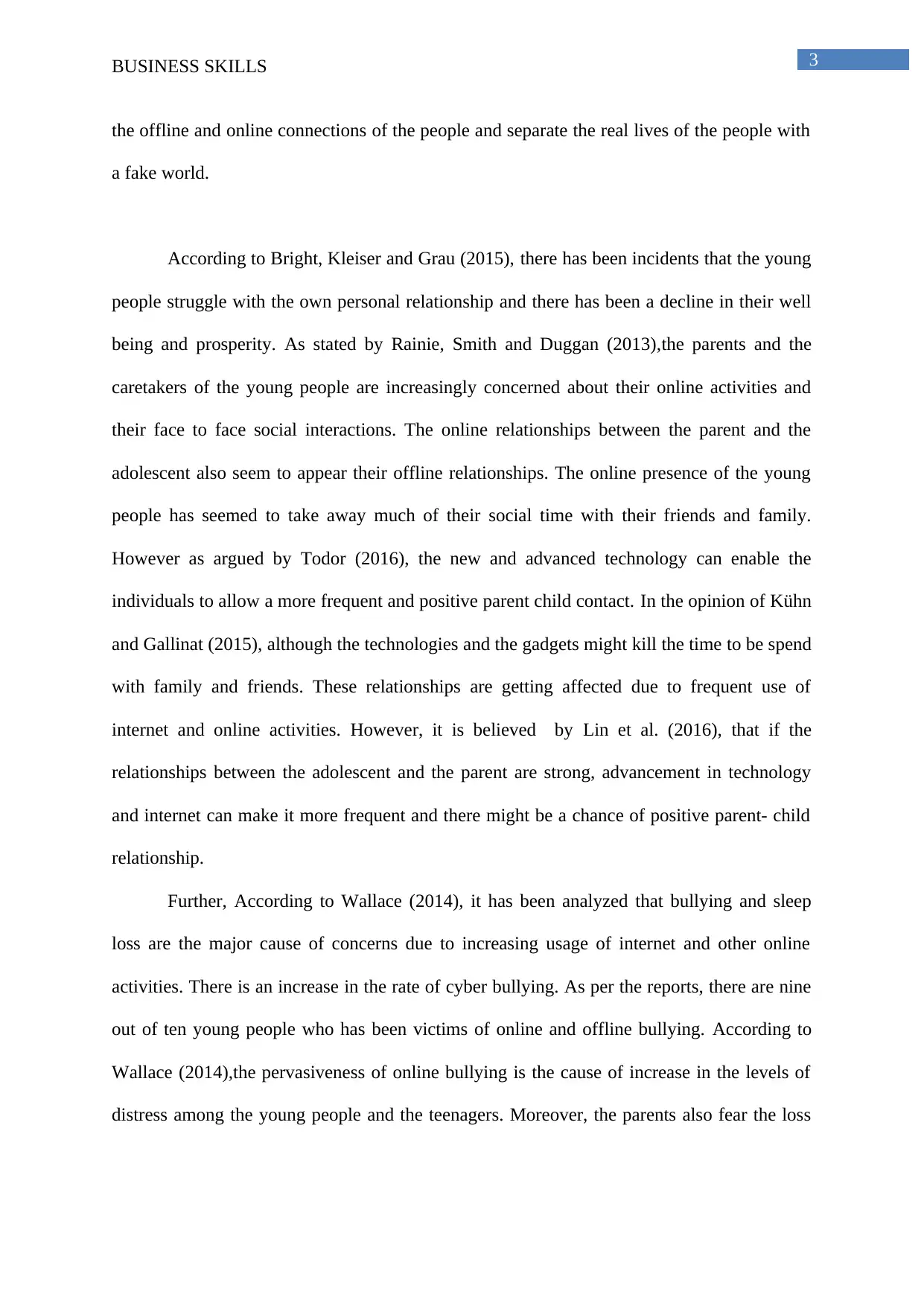
3BUSINESS SKILLS
the offline and online connections of the people and separate the real lives of the people with
a fake world.
According to Bright, Kleiser and Grau (2015), there has been incidents that the young
people struggle with the own personal relationship and there has been a decline in their well
being and prosperity. As stated by Rainie, Smith and Duggan (2013),the parents and the
caretakers of the young people are increasingly concerned about their online activities and
their face to face social interactions. The online relationships between the parent and the
adolescent also seem to appear their offline relationships. The online presence of the young
people has seemed to take away much of their social time with their friends and family.
However as argued by Todor (2016), the new and advanced technology can enable the
individuals to allow a more frequent and positive parent child contact. In the opinion of Kühn
and Gallinat (2015), although the technologies and the gadgets might kill the time to be spend
with family and friends. These relationships are getting affected due to frequent use of
internet and online activities. However, it is believed by Lin et al. (2016), that if the
relationships between the adolescent and the parent are strong, advancement in technology
and internet can make it more frequent and there might be a chance of positive parent- child
relationship.
Further, According to Wallace (2014), it has been analyzed that bullying and sleep
loss are the major cause of concerns due to increasing usage of internet and other online
activities. There is an increase in the rate of cyber bullying. As per the reports, there are nine
out of ten young people who has been victims of online and offline bullying. According to
Wallace (2014),the pervasiveness of online bullying is the cause of increase in the levels of
distress among the young people and the teenagers. Moreover, the parents also fear the loss
the offline and online connections of the people and separate the real lives of the people with
a fake world.
According to Bright, Kleiser and Grau (2015), there has been incidents that the young
people struggle with the own personal relationship and there has been a decline in their well
being and prosperity. As stated by Rainie, Smith and Duggan (2013),the parents and the
caretakers of the young people are increasingly concerned about their online activities and
their face to face social interactions. The online relationships between the parent and the
adolescent also seem to appear their offline relationships. The online presence of the young
people has seemed to take away much of their social time with their friends and family.
However as argued by Todor (2016), the new and advanced technology can enable the
individuals to allow a more frequent and positive parent child contact. In the opinion of Kühn
and Gallinat (2015), although the technologies and the gadgets might kill the time to be spend
with family and friends. These relationships are getting affected due to frequent use of
internet and online activities. However, it is believed by Lin et al. (2016), that if the
relationships between the adolescent and the parent are strong, advancement in technology
and internet can make it more frequent and there might be a chance of positive parent- child
relationship.
Further, According to Wallace (2014), it has been analyzed that bullying and sleep
loss are the major cause of concerns due to increasing usage of internet and other online
activities. There is an increase in the rate of cyber bullying. As per the reports, there are nine
out of ten young people who has been victims of online and offline bullying. According to
Wallace (2014),the pervasiveness of online bullying is the cause of increase in the levels of
distress among the young people and the teenagers. Moreover, the parents also fear the loss
Paraphrase This Document
Need a fresh take? Get an instant paraphrase of this document with our AI Paraphraser
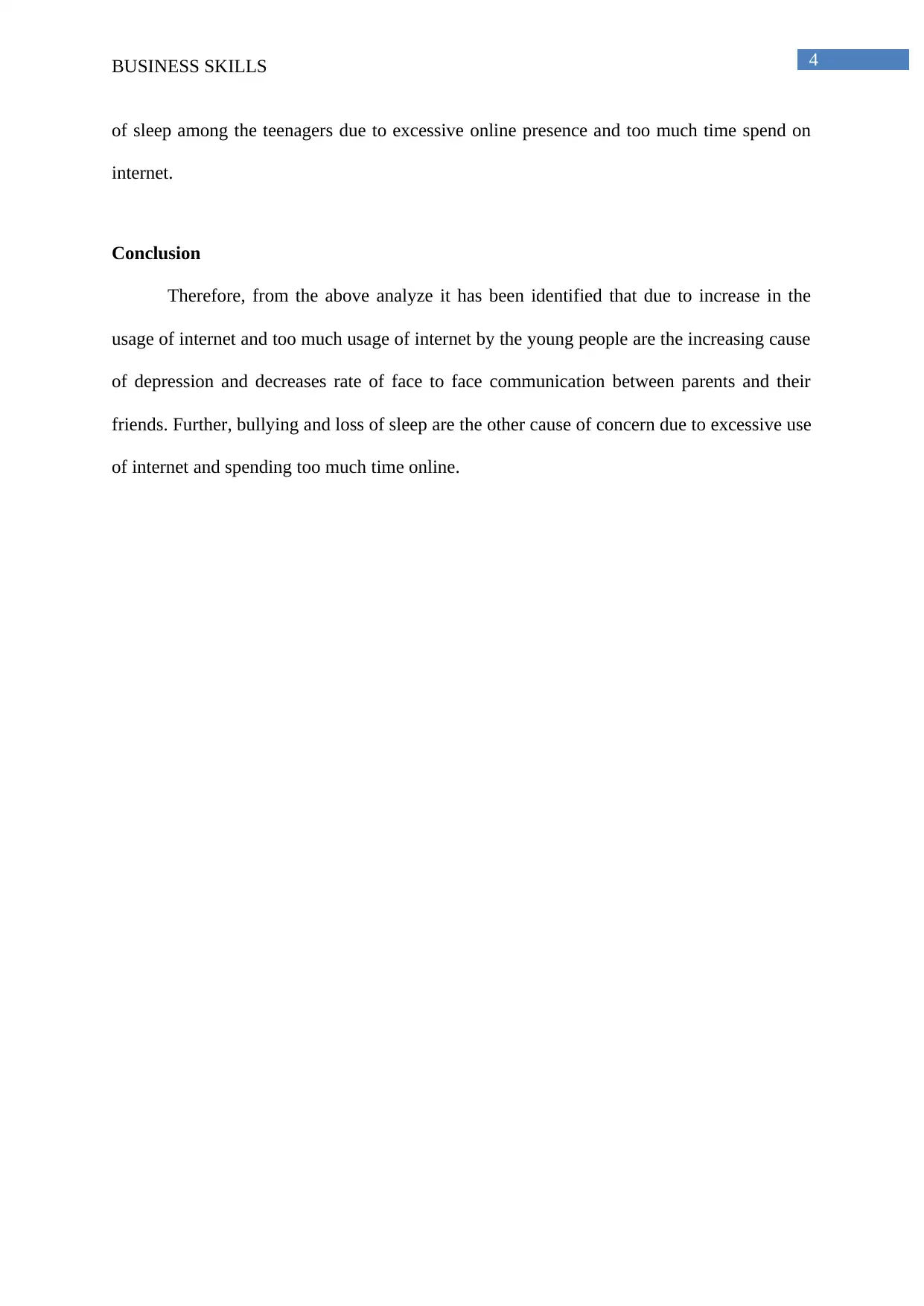
4BUSINESS SKILLS
of sleep among the teenagers due to excessive online presence and too much time spend on
internet.
Conclusion
Therefore, from the above analyze it has been identified that due to increase in the
usage of internet and too much usage of internet by the young people are the increasing cause
of depression and decreases rate of face to face communication between parents and their
friends. Further, bullying and loss of sleep are the other cause of concern due to excessive use
of internet and spending too much time online.
of sleep among the teenagers due to excessive online presence and too much time spend on
internet.
Conclusion
Therefore, from the above analyze it has been identified that due to increase in the
usage of internet and too much usage of internet by the young people are the increasing cause
of depression and decreases rate of face to face communication between parents and their
friends. Further, bullying and loss of sleep are the other cause of concern due to excessive use
of internet and spending too much time online.
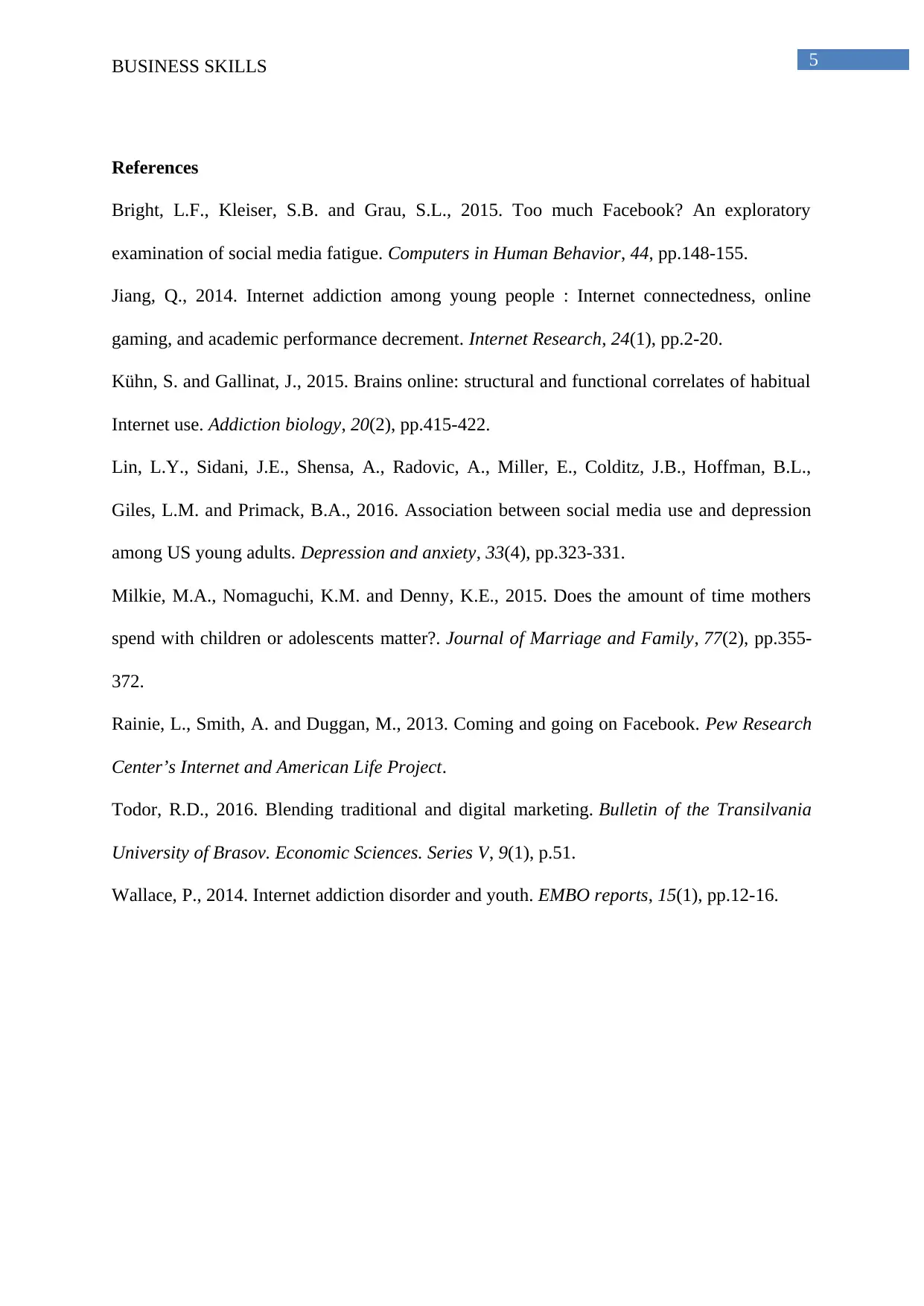
5BUSINESS SKILLS
References
Bright, L.F., Kleiser, S.B. and Grau, S.L., 2015. Too much Facebook? An exploratory
examination of social media fatigue. Computers in Human Behavior, 44, pp.148-155.
Jiang, Q., 2014. Internet addiction among young people : Internet connectedness, online
gaming, and academic performance decrement. Internet Research, 24(1), pp.2-20.
Kühn, S. and Gallinat, J., 2015. Brains online: structural and functional correlates of habitual
Internet use. Addiction biology, 20(2), pp.415-422.
Lin, L.Y., Sidani, J.E., Shensa, A., Radovic, A., Miller, E., Colditz, J.B., Hoffman, B.L.,
Giles, L.M. and Primack, B.A., 2016. Association between social media use and depression
among US young adults. Depression and anxiety, 33(4), pp.323-331.
Milkie, M.A., Nomaguchi, K.M. and Denny, K.E., 2015. Does the amount of time mothers
spend with children or adolescents matter?. Journal of Marriage and Family, 77(2), pp.355-
372.
Rainie, L., Smith, A. and Duggan, M., 2013. Coming and going on Facebook. Pew Research
Center’s Internet and American Life Project.
Todor, R.D., 2016. Blending traditional and digital marketing. Bulletin of the Transilvania
University of Brasov. Economic Sciences. Series V, 9(1), p.51.
Wallace, P., 2014. Internet addiction disorder and youth. EMBO reports, 15(1), pp.12-16.
References
Bright, L.F., Kleiser, S.B. and Grau, S.L., 2015. Too much Facebook? An exploratory
examination of social media fatigue. Computers in Human Behavior, 44, pp.148-155.
Jiang, Q., 2014. Internet addiction among young people : Internet connectedness, online
gaming, and academic performance decrement. Internet Research, 24(1), pp.2-20.
Kühn, S. and Gallinat, J., 2015. Brains online: structural and functional correlates of habitual
Internet use. Addiction biology, 20(2), pp.415-422.
Lin, L.Y., Sidani, J.E., Shensa, A., Radovic, A., Miller, E., Colditz, J.B., Hoffman, B.L.,
Giles, L.M. and Primack, B.A., 2016. Association between social media use and depression
among US young adults. Depression and anxiety, 33(4), pp.323-331.
Milkie, M.A., Nomaguchi, K.M. and Denny, K.E., 2015. Does the amount of time mothers
spend with children or adolescents matter?. Journal of Marriage and Family, 77(2), pp.355-
372.
Rainie, L., Smith, A. and Duggan, M., 2013. Coming and going on Facebook. Pew Research
Center’s Internet and American Life Project.
Todor, R.D., 2016. Blending traditional and digital marketing. Bulletin of the Transilvania
University of Brasov. Economic Sciences. Series V, 9(1), p.51.
Wallace, P., 2014. Internet addiction disorder and youth. EMBO reports, 15(1), pp.12-16.
⊘ This is a preview!⊘
Do you want full access?
Subscribe today to unlock all pages.

Trusted by 1+ million students worldwide
1 out of 6
Related Documents
Your All-in-One AI-Powered Toolkit for Academic Success.
+13062052269
info@desklib.com
Available 24*7 on WhatsApp / Email
![[object Object]](/_next/static/media/star-bottom.7253800d.svg)
Unlock your academic potential
Copyright © 2020–2025 A2Z Services. All Rights Reserved. Developed and managed by ZUCOL.





